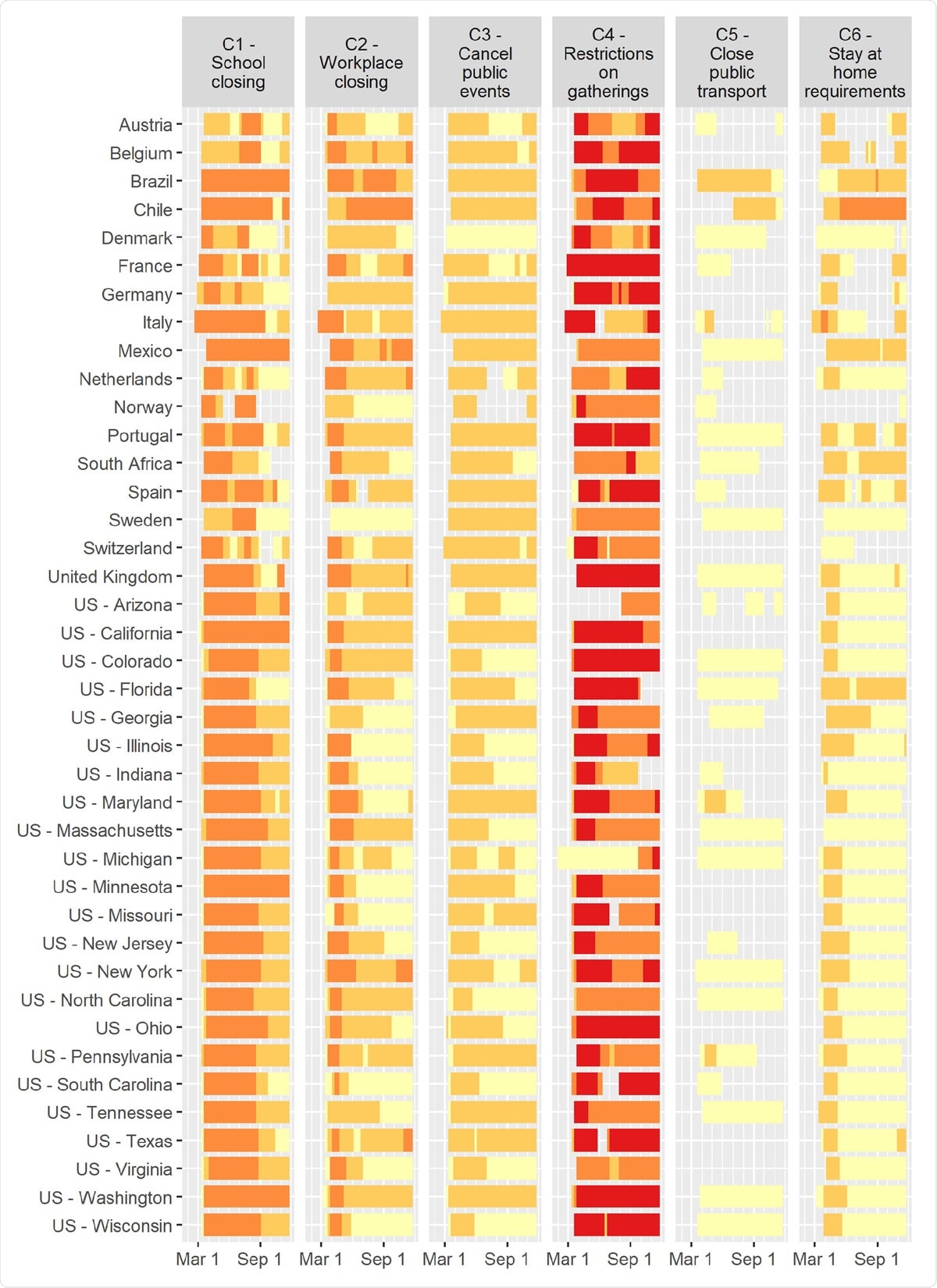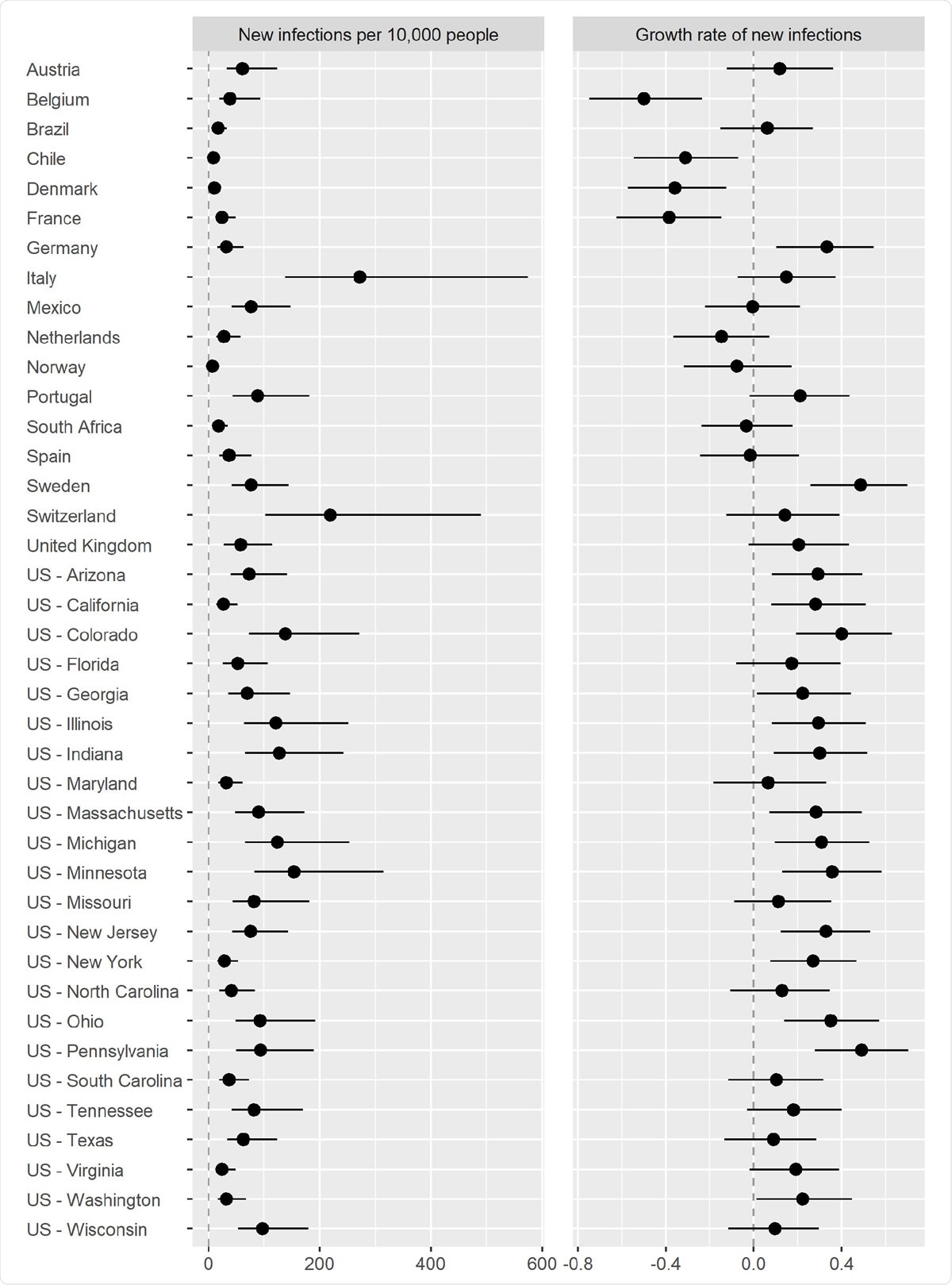Across 40 countries, regions, and US states, various control policies have been put in place, ranging from lockdowns and closures of schools and workplaces to restrictions on gatherings in public, and on international travels. The current study, published on the preprint server medRxiv* in December 2020, provides estimates of the impact of the individual policies in each of these "jurisdictions", as they are called, taking each of five areas into account:
- The range of measures implemented
- The level of implementation of containment measures
- The extent of compliance
- The number of COVID-19 cases, deaths and excess deaths
- The performance of the range of measures in other regions

COVID policy levels by week based on OxCGRT database.

 This news article was a review of a preliminary scientific report that had not undergone peer-review at the time of publication. Since its initial publication, the scientific report has now been peer reviewed and accepted for publication in a Scientific Journal. Links to the preliminary and peer-reviewed reports are available in the Sources section at the bottom of this article. View Sources
This news article was a review of a preliminary scientific report that had not undergone peer-review at the time of publication. Since its initial publication, the scientific report has now been peer reviewed and accepted for publication in a Scientific Journal. Links to the preliminary and peer-reviewed reports are available in the Sources section at the bottom of this article. View Sources
Core and Additional Policies
The researchers found that overall, each of the policies and the required levels of implementation to reduce the rate of growth of COVID-19 infection to below zero correlate highly with the compliance in the population with the core containment policies. Interestingly, these have a lower impact on social interactions.
The core policies include not holding any public events, having less than 100 people at gatherings, stay-at-home recommendations, restrictions on internal movement, partial international travel ban and public information campaigns. However, by themselves, these do not arrest the pandemic, thus necessitating the implementation of some of the policies from the group that has a higher impact on the population at large, are harder to tolerate, and are more restrictive.
Thus, the researchers discuss both the 'core' policies and the 'additional high-impact' policies in terms of their impact. The latter, each of which reduces the virus growth rate by 10 percentage points at least, include: targeted or full workplace closings for all but essential workers, stay-at-home requirements, and targeted school closings. The best combination of policies from this category must be designed based on the level of compliance with core policies and how they interact with each other.

Weekly rate of new infections and their growth by jurisdiction as of November 22, 2020. Dots = median estimates; Lines = 95% intervals
Evaluating Policy Impacts
The effects of changing policies can be evaluated most accurately only if there is reliable data on infections and deaths, which have been hard to obtain in the best of situations due to various serious obstacles, including inadequate testing kits and poor test sensitivity, as well as late initiation of testing.
COVID-19 deaths have also been poorly reported for a variety of reasons. Therefore, the researchers used Bayesian inferential methods to assess the consequences of these health policies, referencing historical infection levels from both COVID deaths and excessive numbers of deaths occurring after a few weeks.
The study was based upon a classical epidemiological SIR model that envisages an exponential growth of infection. They used the Bayesian approach for the observed data because they can make stochastic inferences about the parameters. It is robust to outliers, thus allowing protection against undue effects due to outliers. Bayesian analysis is also resilient to further constraining parameters and stochastic assumptions.
The researchers used global case fatality rate data, with probabilistic nesting of infection-to-death delays within the models of transmission within each region. The weekly COVID infection and death data came from the Johns Hopkins University COVID dashboard. Data on weekly expected deaths is from The Economist dataset.
Levels of Intervention, Compliance, and Effectiveness
Intervention data in eleven categories was obtained from the weekly reports in the Oxford COVID-19 Government Response Tracker (OxCGRT) database. The researchers ranked each policy level from the lowest level of restriction, at 1, to the highest level, at 4.
They reported the mean impact of each of the policies across all the jurisdictions if simultaneously implemented across all jurisdictions. They also reported the proportion of jurisdictions with any given policy being enforced. Thirdly, they examined the number of new infections and the growth in the rate of infections in each region, as well as the estimated rate of growth per week if four core policies were put in place in each jurisdiction.
This allowed the investigators to examine the level of compliance with and the subsequent impact of each of the four base policies in each jurisdiction. Finally, they also explored how effectively a portfolio of widely implemented core policies could contain the virus and what additions would be needed from the second category.
What are the Conclusions?
The study is unique in studying the impact of different policies, enforced at varying levels, in many different jurisdictions.
The researchers concluded that five of the 11 policies have a large impact if completely implemented at high levels. These include workplace and school closures, limited internal travel, sheltering in place, and disseminating public information. The last is notably effective only if carried out at the highest intensity. All have to do with controlling transmission between adults.
Interestingly, infection growth rates are highest in Sweden, Colorado, and Pennsylvania, at about 49% new cases per week, but are also high in Italy and Switzerland. In other regions, the growth rate is near zero. The researchers attribute this to differences in policy as well as in compliance, partly dependent on population density.
The study highlights the fact that in Sweden, where only the base policies were implemented, the growth rate of infections reduced dramatically at first but is now increasing. In contrast, in Denmark, where additional policies were implemented from the beginning, the growth rate is now lower than that of Sweden. The underlying factors for Sweden's early success could have included the low population density, weather, and demographics. Many South American countries, and Spain, failed to observe the same success with only base policies.
Again, core policies succeed only in jurisdictions with the highest compliance, have a strong but still inadequate effect in jurisdictions with median compliance. They point out that "for 90% of jurisdictions, the core policies are insufficient to achieve COVID control." Stricter policies will, therefore, be needed to arrest the growth of infection, as discussed earlier. Despite their higher cost to society, they will become necessary to limit virus spread.

 This news article was a review of a preliminary scientific report that had not undergone peer-review at the time of publication. Since its initial publication, the scientific report has now been peer reviewed and accepted for publication in a Scientific Journal. Links to the preliminary and peer-reviewed reports are available in the Sources section at the bottom of this article. View Sources
This news article was a review of a preliminary scientific report that had not undergone peer-review at the time of publication. Since its initial publication, the scientific report has now been peer reviewed and accepted for publication in a Scientific Journal. Links to the preliminary and peer-reviewed reports are available in the Sources section at the bottom of this article. View Sources